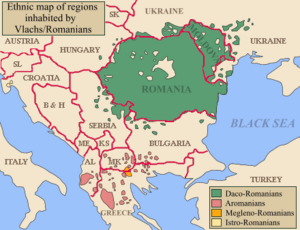Balkan Romance languages facts for kids
Quick facts for kids Balkan Romance |
|
|---|---|
| Geographic distribution: |
Balkans and part of Eastern Europe |
| Linguistic classification: | Indo-European
|
| Subdivisions: |
Romanian (Daco-Romanian)
Istro-Romanian
Megleno-Romanian
|
 Geographical distribution of the four Balkan Romance languages in the early-20th-century
|
|
The Balkan Romance languages are a group of languages spoken in the Balkans region of Europe. They are part of the larger Romance language family, which comes from Latin. These languages are special because they developed differently from other Romance languages like Spanish or French.
There are four main Balkan Romance languages. They are Aromanian, Romanian (also known as Daco-Romanian), Istro-Romanian, and Megleno-Romanian.
Contents
What are Balkan Romance Languages?
Balkan Romance languages are a branch of Eastern Romance languages. This means they are Romance languages that grew in the eastern part of the old Roman Empire. They are spoken mainly in Southeastern Europe.
These languages all came from the Latin spoken by Roman soldiers and settlers. This happened many centuries ago in the Balkan Peninsula. Over time, this Latin changed and became these new languages.
Where are these languages spoken?
The Balkan Romance languages are spoken in different parts of the Balkans. Romanian is the most widely spoken. It is the official language of Romania and Moldova.
Aromanian is spoken by people called Aromanians. They live in several countries like Greece, Albania, North Macedonia, and Bulgaria. Istro-Romanian is spoken by a small group in Croatia. Megleno-Romanian is also spoken by a small group, mainly in Greece and North Macedonia.
How did these languages develop?
The story of Balkan Romance languages starts with the Roman Empire. The Romans conquered the Balkan region a long time ago. They brought their language, Latin, with them.
Over many centuries, the Latin spoken in the Balkans changed. It was influenced by other languages in the area. These included Slavic languages, Albanian, and Greek. This mix of influences made Balkan Romance languages unique.
Why are they different from other Romance languages?
Balkan Romance languages have some features that are not found in Western Romance languages. For example, they have a special way of forming the future tense. They also have some unique grammar rules.
One interesting feature is how they use articles. Instead of putting the article before the noun (like "the house"), they often attach it to the end of the noun (like "house-the"). This is similar to how some other Balkan languages work.
The Four Balkan Romance Languages
Each of the four languages has its own history and community. They are all related but have their own special traits.
Romanian (Daco-Romanian)
Romanian is the largest of the Balkan Romance languages. It is spoken by millions of people. It is the national language of Romania.
Romanian has a rich history and literature. It has been influenced by many languages over time. These include Slavic languages, Turkish, and Hungarian.
Aromanian
Aromanian is spoken by the Aromanians, who are also called Vlachs. They are a nomadic or semi-nomadic people. They traditionally lived as shepherds.
Aromanian has many old Latin words that are not found in Romanian. It also has strong influences from Greek and Albanian.
Istro-Romanian
Istro-Romanian is a critically endangered language. This means very few people still speak it. It is spoken in a small part of the Istria peninsula in Croatia.
Its speakers are descendants of people who moved from other parts of the Balkans. They settled in Istria many centuries ago.
Megleno-Romanian
Megleno-Romanian is another small and endangered language. It is spoken in a few villages in Greece and North Macedonia.
This language has been heavily influenced by Slavic languages and Turkish. It is quite different from Romanian.
Images for kids
See also
 In Spanish: Lenguas romances orientales para niños
In Spanish: Lenguas romances orientales para niños


